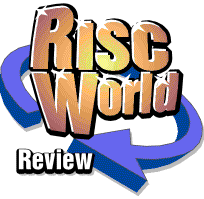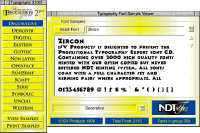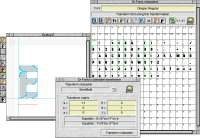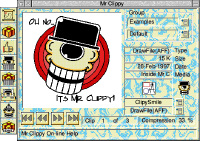



DrawWorks Millennium
While we all wait for what can seem like a thousand years for Cerilica Vantage, Richard Goodwin looks at iSV's supercharged version of Acorn's Draw.
(Click on the small images to load larger versions in a new window. Right-click to load them into a new window in most browsers).
DrawWorks Millennium is a somewhat schizophrenic package in many ways; despite taking its name from a graphics package, over half of the CD is given over to fonts, and a good deal of the rest of the disc is clip-art. Then there's the fact that the graphics package isn't really a package at all, it's a bolt-on to an existing program, although because this other program Acorn's Draw, there shouldn't be anyone without a copy. And as for the characters of Dr. Fonty and Mr. Clippy ... well, that's another story. So I hope you'll forgive me if it's a little difficult knowing where to begin.
Drawing
Let's start, however, with the package that gives the disc it's name - DrawWorks Millennium, or DWM for short. As with all the programs and resources in this package you can install to your hard drive or run straight from the CD. In fact, for technical reasons that are too tedious to go into here, I was running them from a CD-ROM drive in a completely separate machine over a network with very few problems, which bodes well for schools with networked resources (although the asking price is just for a single-use copy, so ask about a site license).
The programs here also run on any machine with 4MB of RAM, from RISC OS 3.1 upwards to a RISC OS 4 StrongARM machine, although obviously you should have at least a CD-ROM drive and probably a hard drive too. The version reviewed was v1.66; a new version is due out for the Wakefield show, and come with extras to do things like improve colour representation in RISC OS as a whole by improving colour dithering and anti-aliasing, but this version will be Risc PC only and 1.66 will be kept on the books for earlier machines.
All the manuals are in electronic format which is good from the point of view of keeping them together with the software, but you can only have one manual loaded at a time and of course there's the old chestnut of not being able to read them in the bath.
DrawWorks Bar
Running DWM also loads a copy of Draw, and by clicking on the Draw icon you get the standard window plus two new toolbars along the top - the lower bar adding new tools, and the upper allowing you to change to other sets of tools. The tools vary from the fairly useful to the pretty unique; for instance it has tools for altering the zoom factor or changing a font's size and colour, which are available in the unaltered version of Draw but require some navigation around the menu structure to find which can be a bore if you're experimenting; but it also has features like a very advanced colour selector which has menus of pantone-alike colours all listed and displayed for you, the ability to tint your images so that they look faded out, or cool tools like a drop-shadow maker, an outlining tool for creating roadmaps, or distortion tools for twisting and bending images. Although many of these effects can be duplicated using other separate programs or some hard slog in ArtWorks, having them all available from within Draw at this price is pretty good going.
The map generating and brightness adjusting tools provided by DrawWorks Millennium.
Two Draw files produced from DWM are included on the CD, the colour wheel and the map outline.
However, there are some issues with the user interface that make using the tools less pleasurable than they could have been. Partly this is due to Draw itself, which can be a bit of a pain sometimes. Selecting an object from within a busy part of a picture has always been awkward, especially after having used ArtWorks for a few years. I mention this primarily because DWM's tools generally work on selected objects, and then unselect those objects after applying an effect. This means that you have to go through the process again every time you want to experiment.
For the most part I can understand the part about having to select parts of an image to apply something to, but it gets a bit wearing sometimes to have an error box pop up all the time, especially for some tools like the print preview. You can emulate printing on, say, yellow paper which is a good thing, but surely if you're printing you're mainly going to be printing the whole page?
Other tools compound the confusion by reacting in an inconsistent manner - the tool to trace objects into roadmap-like thick outlines works in situ, but the drop shadow tool next to it requires you to save out a separate file first (even though you can 'save' it to the current Draw window). Importing foreign file formats is a good thing; howver, the importer says it can't import Draw files or Sprites - which are handled natively in Draw - which seems a little lazy when they could have been passed straight through to the main program. Also some of the toolbars are wider than the Draw window (when using A4 paper and/or smaller screen sizes) which requires a bit of scrolling to see all the tools; it's harder to say how this could have been implemented better, but it's not as easy as it might otherwise have been.
Case in point: one of the most pointless and annoying of tools is the 'insert named file' window; it's just a window with a beige text input box and an OK button, which doesn't accept drag-and-dropped files, and doesn't have a Cancel button or even a close icon on the title bar. It doesn't even close when Draw loses input focus - the import file window does, which I found annoying after trying to hunt through my messy Desktop for files, but you should really pick one model or the other and stick to it. After fiddling around for a while I had to click on the OK button and get an error box for my troubles.
It's only a little thing, but it's a pointless tool (who types in filenames manually to load files?) which has been badly implemented in so many ways when it would have been easier to do it right (like not changing the default colours or switching off standard window furniture). It makes the learning curve of the program just that bit steeper for no real benefit, which is something to bear in mind in a classroom environment. A pity that it should mar some otherwise excellent tools.
Fonts
And so on to the fonts. The disc contains a program called Typo2100, which, as the second part of the name suggests (casting aside any jokes about a design package containing an obvious Typo), houses some 21 hundred typefaces. This compares favourably with other offerings - for instance, Zenta Multimedia's RISC OS Font Emporium has just 550 fonts, while Harry Decker's website (fonts.iconbar.com) had some 2,500 fonts when last I checked. However, Harry decker's site concentrates on having lots of different fonts with wildly differing levels of character set support, rather than a good solid collection of quality fonts in as many styles as possible as we have here. Grouped into 13 categories (Decorative, Script, SansSerif etc.), the disc comes with an excellent previewing program which shows a large body of text and some common characters to show the font off in its best light. This is quick as the previews are stored as sprites - it doesn't really matter about disc space when you're using a CD.
Although I say that it's an excellent program, it is marred by a completely style guide busting interface; having been on the receiving end of several e-mails in the past for minor infractions in the positioning of icons or menus in my own programs, I shudder to think what the same people would say if I inflicted this shiny yellow monstrosity on them. Many of the other applications on the CD are inflicted with the same lack of taste - Mr. Clippy the clipart manager is so bad (beige-yellow with cyan swirls) that I think that even the programmer was put off enough to add an option to switch it off, but no such luck here. All of this is particularly ironic given that they're part of a design package, you really have to look past the design and try to concentrate on the content.
The rather non-standard yellow and blue windows
If you don't find the font you want in Typo2100 then there are a collection of applications to help you design or modify your own. Although some of them intersect - Dr. Fonty offering much that can be found in the separate FontTrixPro for instance, although FontTrixPro is more automated - it's a good selection with some handy features. For instance, having downloaded some fonts from the aforementioned website it's sometimes off-putting to switch to a different font in, say, Impression, only to find that there's no lower case letters so most of your text vanishes. With Dr. Fonty a click or two of the mouse generates a 'small caps' version of the capital letters in the lower case area, which is pretty cool. Being an amateur font fan (I love to use them, I just can't be bothered to create my own) I find it much more enjoyable to modify someone else's fonts to fit my needs; there's even a program to suggest what font to use in a given situation, or match the fonts to their PostScript counterparts. A solid collection of resources then, representing good value for money.
Dr. Fonty in action
Clip-art
The inclusion of clip-art on a CD usually brings out one of two reactions - it's either a useful collection of resources, or 'shovelware' (included only to fill up extra space). This selection does add something to the disc however, and is a good, varied mix of bitmap and vector format images from a variety of sources (Akalat, APDL, Fabis, Smart DTP, and Christopher Jarman).
Obviously it's possible that you might have acquired some of these images before (as with other parts of the CD), but going to multiple sources should keep the likelihood of this to a minimum so kudos there. Obviously I didn't have time to go through the whole 160MB of data, but a quick sample showed a good mix of JPEG format photographs, some Sprite format scans of engravings and postcards, and some Draw format vector images; the photographs especially were of excellent quality, very clear and properly cropped so there's no obvious borders from where they've been scanned from a 35mm slide as with some collections.
An example of the quality of the clipart
I've already touched on the rather dire default colour scheme of the clipart previewer Mr. Clippy, so I'll just warn you that it sings to you when you start it up. Yes, that's right, sings. It's amusing the first couple of times, but gets tired real fast and I can only imagine what it would be like with a whole classroom full of computers doing it. You can't turn it off, and as with all the programs on the disc you can't hurry up the loading banners by clicking on them or pressing keys. I suggest a little judicious pruning of the !Run file of these programs before letting them out into general circulation. The Windows-style help wizards that pop up at the start of many of the programs are less annoying though, especially as Eric Morcombe puts in a guest appearance now and again, and you can switch them off from the preferences window.
If you think this is bad, wait until he starts singing!
Conclusion
So all in all, this is a fairly well-balanced collection of resources for the designer on a budget. Would I recommend this package to the serious designer over, say, the old workhorse of ArtWorks, or the up and coming Vantage? Well, no. The main package might add some fine bells and whistles, but in the end you're still stuck with the interface of Acorn's Draw, with all its annoyances in selecting items near other items and the like, and adds a few of its own.
If you have plenty of money and are serious about getting into design, you'd be better off with a proper design application, but to be honest I doubt that iSV are aiming at the professional market. Would I recommend it to someone on a budget who just wanted an all-round package of resources? With a few reservations on the interface design and so on (for some reason on my 40MB machine the memory allocation went a little screwy and the electronic manual sometimes ended up taking about 28MB of memory, DWM often snatching a further 2MB or more), then yes; some of the individual parts, such as the font collection or the colour handling and special effects of DWM are worth the admission price on their own, and would serve the needs of a hard up student or school quite well.
Product details
| Product: | DrawWorks Millennium |
| Supplier | iSV Products |
| Price: | £40 + p&p (Site licence £80 + p&p) |
| Address: | 86 Turnberry, Home Farm, Bracknell, Berkshire RG12 8ZH |
| Tel: | (01344) 455769 |
| WWW: | www.isvproducts.co.uk |
| E-mail: | atimbrell@aol.com |
Richard Goodwin





